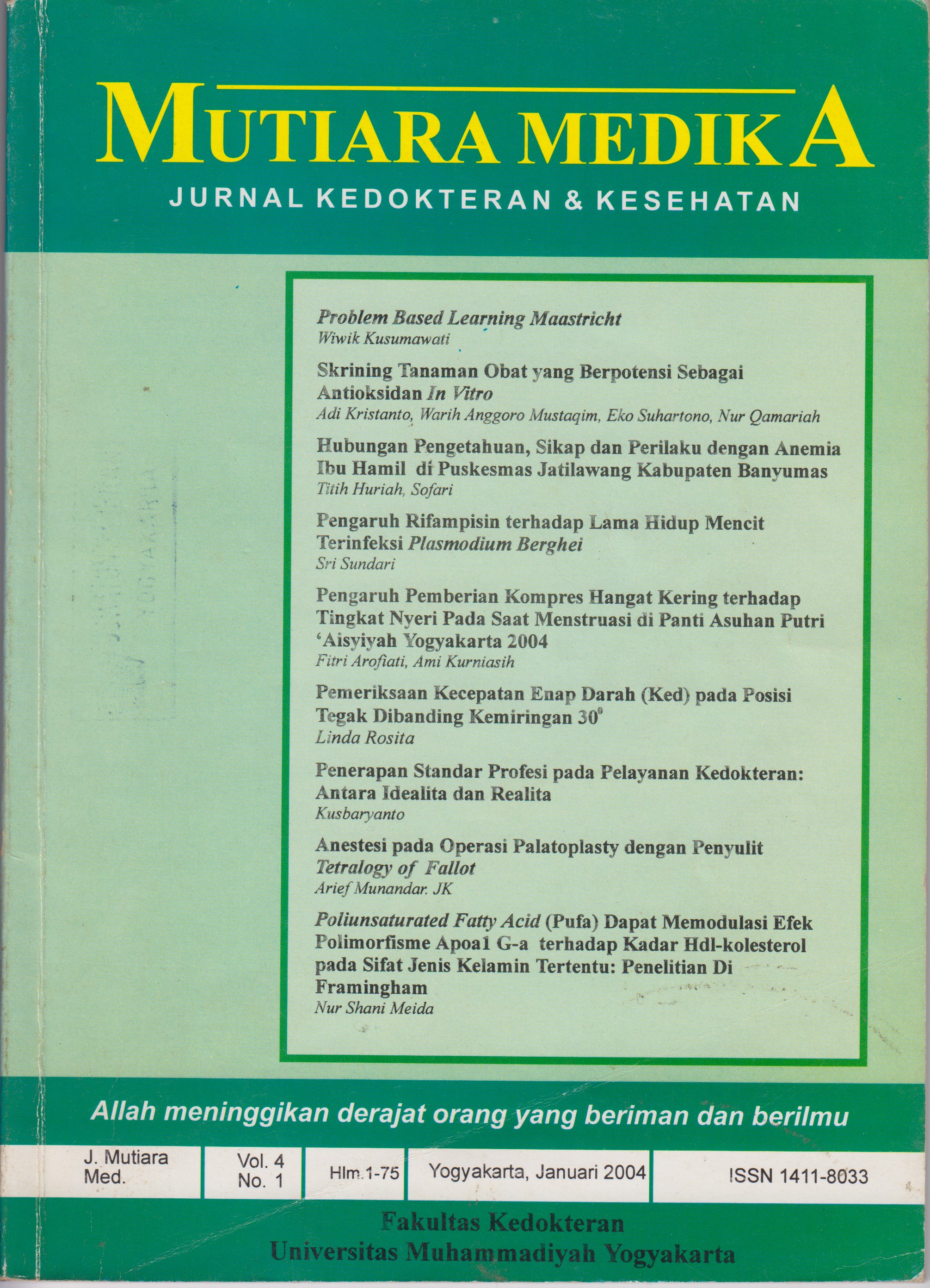Skrining Tanaman Obat yang Berpotensi Sebagai Antioksidan In Vitro
DOI:
https://doi.org/10.18196/mmjkk.v4i1.1707Keywords:
brotowali, pare, tapak dara, antioksidan, bitter melon, madagascar periwinkle, antioxidantAbstract
Brotowali (Tinospora crispa [L] miers), bitter melon (Momordica charantia), and madagascar periwinkle (Catharanthus rosesus [L.] G. Don) are plants that have been used for some disease treatments. The mechanism of action of these plants to cure some diseases corellate with the balance of oxidant and antioxidant. To prove that statement, this study was conducted to evaluate the of antioxidant potential activity in these plants. The method used was antioxi¬dant trial activity with modification of DNP method. The result showed that Madagascar periwinkle (Catharanthus rosesus [L.] G. Don) infusion has the highest antioxidant activity, that was 90, 27%.
Tanaman brotowali (Tinospora crispa [L] miers), pare {Momordica charantia), dan tapak dara {Catharanthus rosesus [L.] G. Don) adalah beberapa tanaman yang telah banyak dipergunakan untuk mengobati berbagai macam penyakit. Mekanisme tanaman tersebut dalam mengobati penyakit diduga terkait dengan keseimbangan antara oksidan dan antioksidan. Untuk membuktikan hal tersebut, maka dilakukan penelitian untuk mengetahui potensi aktivitas antioksidan tanaman brotowali, pare, dan tapak dara. Metode yang dipakai berupa pengujian aktivitas antioksidan dengan metode DNP yang dimodifikasi. Hasil penelitian menunjukkan bahwa infus daun tanaman tapak dara {Catharanthus rosesus [L.] G. Don) mempunyai aktivitas antioksidan paling baik, yaitu 90,27 %.
References
Isa M, 2001. Peranan Oksidan dan Antioksidan pada Penyakit Paru. Disampaikan pada Seminar Ilmiah Radikal Bebas dan Patogenesis Penyakit Serta Peranan Antioksidan dalam Meningkatkan Kesehatan untuk Menuju Indonesia Sehat 2001, Banjarbaru
Moclock N, 2001. Infertilitas Pria, Radikal Bebas, dan Antioksidan. Disampaikan pada Kursus Penyegar 2001 Radikal Bebas dan Antioksidan dalam Kesehatan, Jakarta
Achmad SA, 1999. Pelestarian dan Pemanfaatan Keanekaragaman Hayati Untuk Meningkatkan Kesejahteraan dan Peradaban Umat Manusia. Bahan Ajar Pelatihan Dosen Ilmu Alamiah Dasar untuk Pendidikan Tinggi, Bandung
Yuliani S, 2001. Prospek Pengembangan Obat Tradisional Menjadi Obat Fitofarmaka. Jurnal Litbang Pertanian, 20(3): 100-105
Suryohusodo P, 2000. Kapita Selekta Ilmu Kedokteran Molekuler. Penerbit PT. Rineka Cipta, Jakarta
M Soniimar, Qamariah N, Sismindari, Mustofa, 2002. Potensi Sitotoksik In Vitro Beberapa Tanaman Obat yang Diduga Aktif Sebagai Antikanker. Majalah Obat Tradisional, 7(21): 1-6
Cowan MM, 1999. Plant Products As Antimicrobial Agents. Clin Microbiol Rev, 12(4): 564-82
Anonim, 2003. Terapi Alam: Tanaman Pelawan Kanker dari Kunyit Putih Hingga Benalu, (www.sinarharapan.co.id/iptek/kesehatan.html)
Budianto R, Setiawan B, Suhartono E, 2003. Potensi Antiradikal In Vitro Infus Tanaman Pasak Bumi (Eurycoma longifolia Jack.) dengan Menggunakan Model Reaksi Fenton. Disampaikan pada Seminar Nasional Teknik Kimia Unika Parahyangan, Bandung
Utami P dan Lentera T, 2003. Tanaman Obat Untuk Mengatasi Diabetes Mellitus. Penerbit AgroMcdia Pustaka, Jakarta
Winarno MW dan Sundari D, 2003. Gambaran Histologi Kelenjar Pankreas Akibat Pemberian Infus Daging Buah Pare (Momordica charantia) Pada Tikus Putih. Cermin Dunia Kedokteran, 140:14-17,
Sadikin M dan Adhiyanto C, 2001. Pengukuran Konsentrasi Senyawa Dikarbonil. Disampaikan pada Pelatihan Radikal Bebas dan Antioksidan dalam Kesehatan: Dasar, Aplikasi, dan Pemanfaatan Bahan Alam, Jakarta
Requena J, Chao CC, Levine RL, StadtmanER, 2001. Glutamic andAminoadipic Semialdehydes are The Main Carbonyl Products of Metal-catalyzed Oxidation of Proteins. ProcNatl Acad Sci, 98(1): 69-74
Barlett BS, Stadyman ER, 1997. Protein Oxidation In Aging Disease, and Oxidative Stress. J Biol Chem, 272 (33): 20313-20329
Cacace S, Schroder G, Wehinger E et al, 2003. A Flavonol O-methyltransferase From Catharanthus Roseus Performing Two Sequential Methlations. Phytochemistry, 62:127-137
Renault JH, Nuzillard JM, Crouerour GL et al, 1999. Isolation Of Indole Alkaloids From Catharanthus roseus by Centrifugal Partition Chromatography In The pH-zone Refining Mode. Journal of Cromatography A, 849: 421-431 17
Tegelen LJV, Moreno PRH, Croes AF et al, 1999. Purification and cDNA Cloning OfIsochorismate Synthase From Elicited Cell Cultures Of Chataranthus roseus. Plant Physiology, 119:705-712
Murray RK, Granner DN, Mayes PA, Rodwell VW, 1996. Biochemistry. 24rd ed, Lange Medical Publication, Toronto
Hartono R, Budianto R, SuhartonoE, 2003. Penentuan Aktivitas Antioksidan Infus Daun Tapak Dara (Catharanthus roseus (1). g. don) In Vitro. Disampaikan pada Seminar Kimia 5 Institut Teknologi Sepuluh Nopember, Surabaya
Downloads
Published
Issue
Section
License
Copyright
Authors retain copyright and grant Mutiara Medika: Jurnal Kedokteran dan Kesehatan (MMJKK) the right of first publication with the work simultaneously licensed under an Attribution 4.0 International (CC BY 4.0) that allows others to remix, adapt and build upon the work with an acknowledgment of the work's authorship and of the initial publication in Mutiara Medika: Jurnal Kedokteran dan Kesehatan (MMJKK).
Authors are permitted to copy and redistribute the journal's published version of the work (e.g., post it to an institutional repository or publish it in a book), with an acknowledgment of its initial publication in Mutiara Medika: Jurnal Kedokteran dan Kesehatan (MMJKK).
License
Articles published in the Mutiara Medika: Jurnal Kedokteran dan Kesehatan (MMJKK) are licensed under an Attribution 4.0 International (CC BY 4.0) license. You are free to:
- Share — copy and redistribute the material in any medium or format.
- Adapt — remix, transform, and build upon the material for any purpose, even commercially.
This license is acceptable for Free Cultural Works. The licensor cannot revoke these freedoms as long as you follow the license terms. Under the following terms:
Attribution — You must give appropriate credit, provide a link to the license, and indicate if changes were made. You may do so in any reasonable manner, but not in any way that suggests the licensor endorses you or your use.
- No additional restrictions — You may not apply legal terms or technological measures that legally restrict others from doing anything the license permits.






